






























































When I was small, my grandparents maintained a small cabinet of VHS tapes that they’d recorded from television. My sisters and I were allowed to choose a few each time we visited by ‘checking them out’ via a clipboard and running log. I can still remember the thrill of Atreyu’s quest to cure the empress and the agony of losing Artax to the sadness of the swamp, a reader’s journey Bastian embarks on when his father tells him to stop fantasizing and start facing reality.
I still think about "The Neverending Story," a film Rotten Tomatoes describes as ‘the power of a young boy’s imagination to save a dying fantasyland’—a sentiment that encapsulates, for me, what all good art strives for.
This issue of IdaHome is about film, but also, more broadly, performance. It is always a fun issue to work on because it asks artists to look at art. Writers examining films which examine opera singers. Writers talking to dog owners who showcase their animals on the stage. Writers interviewing recording studio folks who are engineering sound for television and film.
 HEATHER HAMILTON-POST
Editor in Chief
HEATHER HAMILTON-POST
Editor in Chief
This issue, especially in Idaho, becomes a sort of Six Degrees of Kevin Bacon in which many of our stories are connected in a beautiful web. We look at the line between fantasy and reality, offering a healthy dose of each.
Learn about dog showing, or traverse the cinematic landscape of Craters of the Moon. Visit Treefort’s Filmfort or the Sun Valley Film Festival, which remains focused on celebrating cinema far and wide. Of course, you don’t have to head to the mountains—Idaho Film Society has plenty to celebrate in downtown Boise’s old bus depot.
Our own Karen Day has a new film out too. "Aria" profiles four opera singers who are up against an industry that can be unkind to folks who don’t quite fit the mold. Some of the film’s music was recorded at Mirror Studios, and you’ll find a story about them too.
No film would be complete without the beginnings of a hero’s journey, so we offer that too by way of an excellent story about Idaho Downwinders, a nonprofit representing people who lived in Idaho between 1951 and 1962 when nuclear weapons were being tested in Nevada.
It’s an issue getting some media attention, so dive with us into freedom of the press and an interview Benjamin Victor, a sculptor with three works in the United States Capitol. Finally, IdaHome scores an interview with Nicholas Kristof, an American journalist and political commentator.
It was striking to me to discover the myriad of ways in which all artmaking is a version of the same thing. We artists are certainly sharing the trenches, and I suspect there are more of us than we know.
See you there, Heather
publisher KAREN DAY
karen@idahorem.com
editor
HEATHER HAMILTONPOST
heather@idahorem.com
art and design JASON JACOBSEN jsngrafix@gmail.com
KALEY WRIGHT design@idahorem.com
director of operations
MARIELLE WESTPHAL admin@idahorem.com
staff photographer KAREN DAY
cover photograph VANESSA PREZIOSE PHOTOGRAPHY
social media
APRIL NEALE
april@idahorem.com
marketing, sales, and distribution admin@idahorem.com
IdaHome Magazine, LLC
P.O. Box 116
Boise, Idaho 83701 208.481.0693
© 2024 IdaHome Magazine. All rights reserved. The opinions expressed by the authors and contributors to IdaHome Magazine are not necessarily those of the editor and publisher.

Cecilia Violetta Lopez, an internationally renowned soprano, grew up in Rupert, Idaho, where she worked alongside her mother and father in the sugar beet fields. Follow her unconventional journey toward opera stardom in "Aria," a brand new documentary from filmmaker and IdaHome publisher Karen Day.
Chelsea Chamber s is a graduate of Boise State University and has been working in media and communications for nearly a decade. She specializes in public relations, print and digital media, and social media management but dabbles in a variety of other areas. Chelsea serves as the Public Information Specialist and Interpretive Coordinator for the Idaho Department of Parks and Recreation and runs a freelance business doing everything from copyediting to consulting.


David Gray Adler is President of The Alturas Institute, a non-profit organization created to advance American Democracy by promoting the Constitution, civic education, gender equality and equal protection of the law. A recipient of teaching, writing and civic awards, Adler has lectured nationally and internationally, and published widely, on the Constitution, presidential power and the Bill of Rights. He is the author of six books.
Sabina Dana Plasse is a professional writer and editor from Baltimore, Maryland, who moved to Idaho more than 15 years ago. Besides writing and editing, she launches start-up events, assists businesses with publicity and marketing, and is an active film reviewer. When not working, she is enjoying the outdoors, traveling, and watching movies.

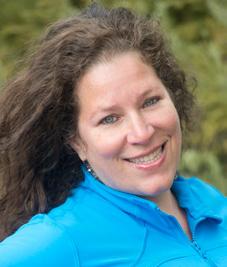
Karissa Manske is an Idaho native Boise transplant who graduated with an English degree but found her calling in tech. When she’s not researching, writing, or editing content about the latest technological advances, chances are she’s shopping for thrift store steals or exploring Idaho’s hiking trails.
Micah Drew is a writer currently based in northwest Montana. A multiple Montana Newspaper Association award-winning journalist covering politics, sports, and the outdoors, he has written for Edible Idaho, Boise Weekly, and High Country News. When not in the newsroom, he can be found trail running throughout the West.


April Neale is the FLAVOR editor. She is a current member of the Critics Choice Awards, Television Critics Association, Gay and Lesbian Entertainment Critics Association, and Alliance of Women Film Journalists. Neale has read original work on NPR and DeLaune Michel's hosted "Spoken Interludes," NPR Marketplace, MSN, Boise Weekly, Idaho Press, Idaho Capital Sun, Yahoo, AOL, MSN Canada, and is also a KTVB Channel 7 "Idaho Today" contributor.
Jodie Nicotra is a freelance writer based out of Moscow, Idaho. She writes for a number of different magazines, including Boise State Magazine, Whitman Magazine, and Central Washington U’s Crimson & Black.

Community + Culture + Recreation + Real Estate

Sonya Feibert Kuhn is a writer, improv nerd, and performer in Boise. She's an avid Treeforter and an enthusiastic patron of and participant in the storytelling and comedy scenes. On sunny days, find her hanging at a local coffee shop or hiking in the foothills.
Karen Day is a photographer and the fearless captain of our fleet of pages and mighty crew. A list of her creative passions and true job description risks making her appear insane, rather than insanely talented. Her habit of climbing onto the ledge of possibility offers us continuous adventures and little sleep. All aboard!








 BY APRIL NEALE
BY APRIL NEALE
If you love cinema, the art of making films, and intelligent conversations of all that entails, Sun Valley Film Festival Director Candice Pate wants to meet you. “[Sun Valley] is very much in the DNA of the event. And we’ve had a lot of luck creating something that attracts interesting, curious, creative heavy hitters in the industry,” she said. “It brings them to this event and this town that disarms people and reminds them of why they got into the business in the first place.”
At Idaho’s most notable annual film festival, don’t expect to see sponsor-filled parties clogged with non-industry influencers. “The audiences that we bring in are super sharp, curious, and cultured, and they ask thoughtful questions. It creates this magic that results in a real celebration of cinema. We’re not a marketplace or about selling films,” explained Pate. “We’re just about people coming together in this destination mountain town with deep Hollywood roots and celebrating the art of storytelling and film.”
Teddy Grennan, Pate’s business partner, started the festival and promoted the idea that meaningful conversations about film can happen over coffee. “Teddy started coffee talks, too. And it’s a signature piece where we insist that our Vision [Award] and honorees participate in this part of the festival, all free and open to the public. It’s a crown jewel and a critical piece we want to share with our audience and give to the community effectively,” Pate said.
The talks, which sometimes bring in big stars like Clint Eastwood, Gwyneth Paltrow, and Annette Bening, also spotlight lesser-known talent, which Pate said can bring more impactful conversations. “We have an excellent reputation, and our audience trusts us; they line up and grab a cup of coffee and hang out,” she said.
Getting the stars and the major players is a deft blend of personal relationships and fortuitous friendships. “It’s gotten easier with a track record of some major guests in our past,” noted Pate, who explained that folks become involved for a variety of reasons— they’re promoting a project or have a personal relationship with somebody who lives here or has a tie to Sun Valley.

And then there’s the passion of it all. “Annette came to us through our PR firm, but then also a film that we’re screening about an organization called Ohana One. They do plastic surgery in third world countries for burn victims and other issues. She’s close with the doctor who started that and very passionate about that project. And so it was kismet when that film was something that our programming team had zeroed in on,” Pate said.
This year, the insider coolness factor is off the charts, with David O’Russell bringing deleted scenes from a classic film. “David O. Russell is breaking down ‘American Hustle’ with deleted scenes—15 minutes of material that didn’t make the final edit and going to share them with the audience and explain why he wished they had been able to be in there or why they were cut,” Pate said.
In year thirteen, the festival will see Annette Bening and David O. Russell honored with the Vision Award and Ted Hope with the Pioneer Award, as well as a host of screenings, which include the opening film, “Ezra,” starring Robert DeNiro, which Pate says is a beautiful, meaningful story.
“The acting is superb. I think it’s probably one of the best performances I’ve ever seen from Robert DeNiro. And that says a lot because he’s clearly a badass,” Pate said.










When faced with the news of a surprise pregnancy, your average college student probably wouldn’t turn to a major in art as a financially stable career direction. And most parents wouldn’t support it. But Boise-based sculptor Benjamin Victor and his family don’t think like most people.
Victor had been doing a lot of artwork on his own, but was skeptical about art as a major. So he called his dad, a teacher and a coach who lived by famous UCLA basketball coach John Wooden’s definition of success as dictated by intrinsic, not extrinsic, factors.
“My dad said, ‘Do what you love. And even if you never make a dime at it, you’ll be a success,’” Victor said. “And so that advice from my dad pushed me to choose art, because I was actually the one who thought it was impractical.”
Benjamin Victor in BSU gear, next to a clay model of Standing Bear (2019). PHOTO COURTESY OF BENJAMIN VICTOR



His dad turned out to be more right than Victor could have dreamed at the time.
Victor fell in love with clay in one of his required courses, and discovered a special passion and talent for sculpting figures. He started getting commissioned for statues when he was just 23 years old. Now he is the only living artist to have three—soon to be four—statues in the National Statuary Hall in the U.S. Capitol.
Victor’s statues, many of which are commissioned, encompass a wide range of social roles. They include prominent Native leaders, civil rights activists, veterans, police, firefighters, athletes, and civil servants.
A good figural piece, Victor says, has three layers. The most shallow layer is subject matter, followed by narrative or story, and concept: that which conveys meaning on a deeper level.
“If you look at my pieces, you can find those levels in all of them,” Victor said. “That’s why they’re often very personal to
me. I love when people look and really try to think about the artwork and what it means.”
Though creating his lifelike bronze sculptures requires a great deal of technical knowledge, for Victor the “how” of sculpting is much less interesting than the “why.”
“In my artwork, concept is king,” he said. “To me, that’s the real creative side of art, and what separates work as art.”
The concept for his statue The Angel, for instance, was born while Victor was collaborating with a photographer on images of professional dancers.
“I was thinking back on art history and romantic art as a movement and how we, as human beings, relate to the world around us,” Victor said. “And the beauty of this young woman in this perfect pose, the grace of it, and yet the temporality that we all have as human beings. It’s really about life and death, beauty and frailty.”
Originally from California, Victor first came to Idaho when he was working on the commissioned statue of the WWII Airman, located in front of the Boise Airport. He enjoyed Boise so much that during another project where he worked on the Steve Appleton monument at Boise State, he accepted an invitation for a longer-term residency at the university. After the residency concluded, Victor decided to stay.
“I don’t always love the traffic, but Boise is a great city,” he said. “You’ve got people that are still willing to help their neighbors, and make friends, and really build a community. It’s just such a great place to live.”
You can find Victor’s statues in Boise and throughout Idaho, including former Boise Junior College coach Lyle Smith, who stands at Albertsons Stadium on Boise State University’s campus. His fourth statue for the National Statuary Hall in the U.S. Capitol, of civil rights activist Daisy Bates, will likely be formally installed in May of this year.
















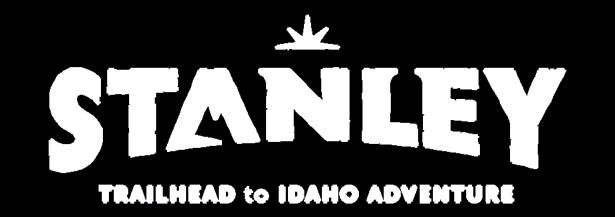
Looking for true Idaho adventure? Explore winter recreation and natural beauty in the Sawtooth Valley. All you need are warm clothes and an adventurous spirit. STANLEYCC.ORG


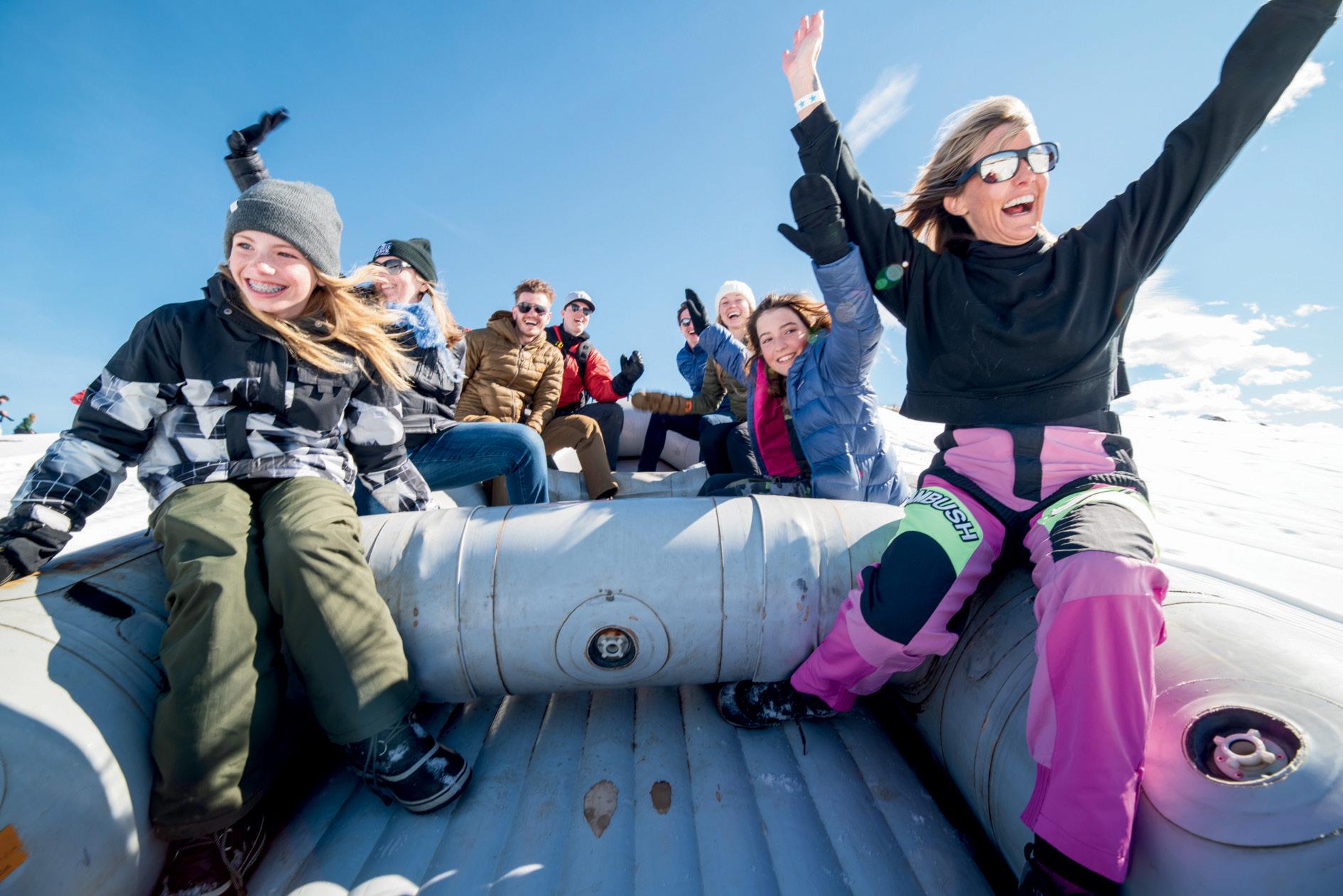

What can be said about the all-encompassing joy of dog ownership that hasn’t already been said? Sure, they provide countless hours of entertainment and social media content, but they’re also a commitment, with their own personalities, strengths and…shall we say…capabilities for growth.

For some dog owners, participating in shows and sporting competitions offers opportunities to bond and showcase their best friends’ exceptional breeding, obedience, energy, or strength. Beyond the thrill of competition, these events help foster a deeper community among dog owners.





In Boise, the Idaho Capital City Kennel Club (ICCKC) is an all-breed American Kennel Club (AKC) member with a mission for community education and a love of di erent dog sports. e club is run by ardent dog lovers, many of whom participate in various competitions. ese competitions include (but are not limited to) conformation, agility, and obedience.
If you’ve ever watched the Westminster Dog Show on TV, you’ve witnessed one of the most well-known conformation events. is level of showmanship isn’t for every dog. In conformation, dogs compete to show how closely they conform to the AKC’s set of breed-speci c standards. is means that, rst and foremost, the dog must be one of the 200 AKC-recognized breeds. Beyond that, they must be at least six months old, not spayed or neutered, and present with breed-speci c physical and temperamental qualities.
“Conformation is a lot of work and commitment, but there’s a whole lot of satisfaction when you do well,” explains ICCKC President Ket Ayling, who has about 30 years of dog showing (Doberman Pinschers exclusively) under her belt.
Ayling, who had her rst exposure to dog competitions through obedience trials, was encouraged to try conformation by other members of her kennel club. “When my dog and I participated in obedience trials, I’d get to see di erent types of

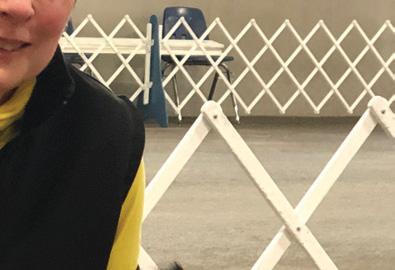




competitions happening throughout the building,” she said. “Seeing conformation trials in action was a great way to be introduced to the sport.”
Since she began, Ayling and her dogs have competed in three national-level AKC conformation trials in Oregon, California, and Kansas. Her current Doberman Pinscher, a four-year-old named Tika, is an AKC Grand Champion and holds a variety of titles in other competitive areas.
Tara Jennings, who began participating in conformation shows with her Bernese Mountain Dog Pippin ve years ago, also began conformation shows through the encouragement of others. “Pippin competes in drafting competitions, but truly enjoys conformation shows because he loves to show o and prance around the ring,” she said.
Ayling and Jennings agree that conformation does have its costs. While entry fees aren’t exorbitant, travel costs can be. To earn the higher titles, points must be earned through a higher participation in shows. However, the high of sharing the cream of the crop for a breed you’re passionate about cannot be overstated.
After a chance viewing of an agility competition at a local fair in 2002, Jan Skurzynski knew she wanted to try the sport with her Australian Shepherd. “After


I saw the sport in action, I thought ‘ is is something I have to try.’ Years later, I’m still passionate about the sport; I compete and judge agility trials throughout the U.S.,” she said.
Agility courses consist of obstacles including jumps, tunnels, weave poles, A-frames and seesaws. Each trial presents these obstacles in a new pattern and handlers only get one quick look at the course before it’s time to compete in a timed run.
“Dog agility is so rewarding because it fosters a deep sense of community between competitors,” Skurzynski explained. “Your achievements do not hinder other competitors from succeeding. Instead, you and your dog are competing against yourselves to reach the next title.”
Skurzynski and her husband Dale Mahoney continue to compete in agility trials with their Border Collies, including her Master Agility Champion, Blazer.
ey’re also AKC-certi ed agility trial judges, traveling the country 25-30 weekends of the year to qualifying trials that generally feed into larger trials, including the annual national agility trial.
Obedience and rally are a bit like two sides of the same coin. Rally was introduced around ten years ago and can
Rey and Skurzynski compete in an agility trial. PHOTO BY JEANNE ALLEN



serve as a stepping stone into more formal obedience. It’s a popular sport with owners of younger dogs or those just getting started in competitions.
“With rally, you can talk to your dog the whole time, while in obedience, you can only give commands,” explained ICCKC Vice President Vicky Runnoe, who began participating in obedience trials in the mid-1980s and continues to both compete with her Border Collies and provide mentorship to others. “Like any dog competition, it takes guts to enter the ring and seeing trainees succeed never gets old.”
Many ICCKC members say that it’s common to see teams start with one area of competition and branch out to new areas as interest and time permit. “Everyone gets to decide how far they want to go with competing and titles. More than anything, it’s a deeply rewarding way to bond with your dog,” shared Runnoe.
If you nd yourself drawn to the idea of dog showing or competition, the ICCKC o ers drop-in open practices and classes focused on a variety of competition types. Club members are present at open










practices to pass on their knowledge and help with skill building. A variety of classes—including AKC S.T.A.R. Puppy and Canine Good Citizen certi cation courses—are also taught by club members.
When it comes time to compete, ICCKC puts on a variety of AKC-backed events that can act as qualifying trials for
larger regional and national trials (and higher titles).
Interested dog enthusiasts are welcome to attend ICCKC’s monthly meeting, held on the fourth Tuesday of each month. For more information, including event and class descriptions, dates, and times, visit the ICCKC website: icckc.org.
Blazer poses with Skurzynski and Mahoney after earning the Master Agility Championship. PHOTO BY RANDY GAINES Top: Jennings and Pippin accept the Best of Opposite Sex award at a conformation trial in Oregon.


 BY KAREN DAY
BY KAREN DAY






New York Times journalist, author, two-time Pulitzer Prize winner, humanitarian, social justice advocate, father, husband, and most recently vintner, Nicholas Kristof has spent his life accumulating challenging job titles and the accolades have followed. is May, he adds memoirist to his resume with the publication of “Chasing Hope,” a compilation of his words and work dedicated to righting the wrongs humanity in icts upon their own. “I guess the title could also be my epitaph,” he said, laughing wryly during an interview on his recent trip to Boise.
www.idahomemagazine.com

Kristof was visiting the Treasure Valley with the NPR host of “Morning Edition,” Steve Inskeep, for a public conversation at the Morrison Center. e Cabin sponsored the event in support of literacy and opposition to booking banning.
ese journalistic powerhouses spent the evening recounting experiences around the globe that have infused their voices with the passion and power to reach millions. Notably, Kristof has a dangerous habit of covering the worst war zones and humanitarian plights, including Darfur, which earned him one of his Pulitzers.
“Darfur was particularly shattering for me,” said Kristof. “I saw genocide and risked my life to try and stop it. It was incredibly frustrating because I could not stop it, but on the other hand, hundreds of thousands of people are alive today because people around the world did respond which has reminded me, despite our human capacity for evil, we also have the capacity for decency, compassion, resilience, and strength.”

happened in my hometown in rural Oregon. One third of the kids on the school bus have been exposed to deaths from drugs, alcohol, and suicide— the problem used to be meth and now it’s fentanyl.” He also mentioned an inprogress, several-year commitment to hike the Paci c Northwest Trail through Montana, Idaho, and Washington with his 20-something daughter.
world and no one pays attention. But if a tree needs a little more water and I give it some, it responds. With cider, if it needs a little more sweetness, I can add something. It’s very rewarding to a ect this kind of physical progress.”


Kristof has documented decades of injustices, making it di cult to imagine how he maintains the ability to see the light in the world’s darkest moments. is balancing is no act; it’s an acquired critical thinking skill and his particular superpower. “I think we journalists in the non-pro t sector tend to focus on the individual stories that are negative, and don’t focus enough on the backdrop of positive progress that is happening every day,” he said.
He went on to explain why he doesn’t get depressed while focusing on seemingly endless bad news.
“When I graduated from college, 41% of the world’s population lived in extreme poverty. Today, it’s less than 10%. When I was kid, the majority of humans had been illiterate throughout history. Now, we’re up to 90% literacy, which is astonishing.” is is Kristof’s second superpower. He knows the data on both sides of the chart, a rare approach in news media, which infamously continues to be driven by the incendiary motto, “If it bleeds, it leads.”

With his life’s work compiled in print, what’s next? “I’d like to do more for the people left behind domestically,” Kristof said. “I’ve been very shaken by what’s

en, there’s the “family project,” on the farm where Kristof was raised. In 2018, www.kristo arms.com began planting cider apples and grape vines. Now, purveyor of hard cider, pinot noir, chardonnay, and rosé contributes yet another job title to Kristof’s resume. “It’s been really good for me,” he said. “In my day job, I spend my time yelling at the
True farmers and humanitarian journalists appreciate hard labor as a kind of tough therapy and Kristof is both. As is his wife, Sheryl WuDunn, the other half of the only married couple to win the Pulitzer Prize as co-writer of their book, “Half e Sky.” eir successful partnership has produced several books and can now be enjoyed with a glass of their chardonnay. Much like the farmwork, Kristof’s writing to upright the wrongs in our world goes on. And on.
“I’d like to write a book on animal rights,” he added. “ e ethical raising of chickens. I’d like to go after the con nement operations. However…” he paused. “ ere has been real progress. I mean the idea that McDonalds would now have cage-free eggs was unfathomable when I started my career.” ere it is again—that superpower. Nicholas Kristof continues to prove that the ability to see both sides of reality is the best way to change it.










Cruising down Idaho’s Highway 20, just outside Arco—the atomic capital of the world—boasts a landscape so unique that nothing quite like it exists anywhere else in the world. A sprawling scene of volcanic rock and lava tubes, Craters of the Moon National Monument covers more than 500,000 acres. The strange terrain became a unit of the National Park Service in 1924, designated by former President Calvin Coolidge who proclaimed it, affectionately, “a weird and scenic landscape peculiar to itself.”
If you have ever been to Craters of the Moon, its namesake is immediately
apparent. For miles and miles in nearly every direction, massive piles of stacked lava rock cover the ground. Volcanic tubes, spatter cones, and intricate tunnels make Craters one of the world’s greatest treasures.
The area was “active” with large-scale volcanic activity between 15,000 and 20,000 years ago but “the geologic forces that shaped this place are omnipresent,” shared Park Superintendent Wade Vagias. “It is considered dormant, not extinct.” The last eruptive phase was about 2,000 or so years ago, but rather than the hulking volcanoes you may expect to see in an area so heavily impacted by volcanic
activity, the magic behind Craters of the Moon happens deep underground.
This year marks exactly 100 years since President Coolidge proclaimed Craters of the Moon a national monument, yet there is still much to be discovered about this unique, otherworldly ground. But you don’t have to be an astronaut or geologist to be fascinated by the secrets at Craters of the Moon! This year, staff will be offering dozens of exciting events and opportunities for exploration all throughout the season to celebrate the centennial. From guided full moon hikes to star parties and more, 2024 is truly the Year of the Crater.


“I think I have the best job in the National Park Service,” Vagias said. “The NPS staff I work alongside are amazingly talented and deeply committed professionals and the many partner organizations we work with provide us unparalleled support as we stand together to serve the needs of the visiting public. It’s truly an honor and a privilege to serve as superintendent of these three great parks.”
 Wade Vagias, who also oversees the management of both the Minidoka National Historic Site and Hagerman Fossil Beds National Monument in addition to Craters of the Moon, couldn’t agree more.
Craters of the Moon will host several star parties to celebrate the Centennial this year. PHOTO COURTESY OF NATIONAL PARK SERVICE/JACOB W. FRANK
Breadcrust lava bombs are among the volcanic features visitors can see at Craters of the Moon. PHOTO COURTESY OF NATIONAL PARK SERVICE
The top of Inferno Cone offers spectacular views of the Great Rift, the Snake River Plain, and the Pioneer Mountains. STOCK.ADOBE.COM/ACKER
Wade Vagias, who also oversees the management of both the Minidoka National Historic Site and Hagerman Fossil Beds National Monument in addition to Craters of the Moon, couldn’t agree more.
Craters of the Moon will host several star parties to celebrate the Centennial this year. PHOTO COURTESY OF NATIONAL PARK SERVICE/JACOB W. FRANK
Breadcrust lava bombs are among the volcanic features visitors can see at Craters of the Moon. PHOTO COURTESY OF NATIONAL PARK SERVICE
The top of Inferno Cone offers spectacular views of the Great Rift, the Snake River Plain, and the Pioneer Mountains. STOCK.ADOBE.COM/ACKER

The history of Craters dates back much further than President Coolidge’s 1924 proclamation. Once the ancestral homeland of native Shoshone-Bannock tribes, the park does their best to keep the stories alive and inclusive, sharing the many narratives that have speckled the past of the area’s history. Dating some 15,000 years ago, deep cracks opened in the earth and lava began rolling out. Slowly, over many years, shaping the landscape as visitors see it today. It is estimated that the most recent volcanic activity in the area occurred some 2,100 years ago and scientists expect there will be more activity sometime in the next 900 years.
One of the most prominent figureheads in Craters’ recent history is Robert Limbert, whose explorations of the land are what spurred President Coolidge’s protective declaration. Limbert spent many years studying the landscape, mapping out the area, and documenting the caves, canyons, and cinder cones, many of which are available for public exploration. NPS offers cave exploration permits for those really looking for a deep dive.
Aside from hiking—in absolute awe—the many miles of trails around the monument, there are plenty of other ways for explorers to uncover the secrets of Idaho’s lunar terrain.

➣ There are 42 first-come, first-served campsites.
➣ There are approximately 60 lava flows and 25 volcanic cones to explore.
➣ This includes one flow referred to as the Blue Dragon, named for its distinct coloration.
➣ There are five caves that can be explored on your own, although there are more than 500 documented in the area. These can be broken into three categories: fissure caves, lava tubes, and weathered caves.
➣ Craters of the Moon is one of the best places for night sky viewing, including stargazing and astrophotography.
➣ Wildflower hikes are popular during springtime.
➣ Learn about the cultural and indigenous history of the monument at the Robert Limbert Visitor Center.
➣ Wilderness Areas: a portion of Craters is actually designated “wilderness.” Without diving into the nuances of the nomenclature, this essentially means an even more protected area. There are many wilderness experiences in this portion of Craters, but all overnight stays require a permit. The permit is free of charge and can be obtained at the visitor center during business hours. But be mindful—because it is a protected wilderness, there are additional rules for wilderness exploration, including no wood fires. So, check the NPS site before your visit!
➣ And so much more!
To learn more about the Craters of the Moon Centennial Celebration and all of the amazing events to look forward to this year, visit them online at nps.gov/crmo/planyourvisit/centennial.htm.










 BY HEATHER HAMILTON-POST
BY HEATHER HAMILTON-POST
When beauty is performed for an audience, something special happens—a joint rapture, which moves through the crowd and transforms us into a part of the whole. You’ve probably felt this at your favorite concert—Taylor Swift or Bruce Springsteen singing directly into your soul. No matter the music, the mutual elation of a live performance creates an unmatched euphoria.
But can opera do that? Honestly, it is probably hard for most of us to know. Opera has a reputation—boring, dull, old, white, and wealthy. At the very least, the audience skews older, even as the art seeks a new kind of spectator.
Imagine then a group of filmmakers connecting with four rising young opera stars over three years to produce something with mass appeal—an authentic human story that challenges our preconceptions about the art form.
“‘Aria’ is about their journeys and challenges, which are so universal. They represent anyone who is trying to achieve something that is seemingly impossible. This film is a stage for
stories about discrimination and body shaming and an industry that lacks significant ethnic diversity. It, and opera, is so much more than a three hour performance with a man wearing a horned hat,” laughed Director Karen Day.
The film complicates our understanding of opera and opera singers, introducing Soprano Cecilia Violetta Lopez, Mezzo Soprano Tahanee Aluwihare, Baritone Brian Major, and Tenor Ben Gulley who are all navigating an industry that neither has enough jobs for the number of talented singers nor wholeheartedly welcomes diversity. In three acts, the film documents the triumphs, failures, and personal interactions of the four singers redefining the artform.
But there’s drama happening onstage too.
“Opera is like telenovela. There’s comedy, there’s drama, there’s a love triangle, someone dies, the whole gamut. The whole artform—it’s just theater and we’re telling these stories as trained singers, that’s all it is,“ explained Lopez.

As a reporter in the war zone for “NBC Nightly News,” Day discovered that she had little control over the content once it was produced, which she felt compromised the true humanitarian situations taking place. So she pivoted to film, where she had more say.
Day bills herself as a social justice and humanitarian filmmaker and also works as the publisher of IdaHome Magazine, which is how she learned about Lopez. After hearing her story, which Day describes as ‘deeply unjust’, she knew it deserved to be told in a film. Opera, which Day knew nothing about, offered the specific architecture of the story while the overt discrimination and determination to thrive against the odds made the message of the story universal.
Lead Editor Christen Skinner wasn’t sure she’d get involved. Since her move to Boise, she’d been busy with client work, though she’d held an interest in film from an early age. In Colorado, she’d worked on longer patient profiles for a local hospital, which ignited her interest in human stories.
“These were real people going through real struggles. Most of them have these amazing stories of overcoming insurmountable odds, which was inspiring. And I thought, ‘how do I do more of this?’,” she said.
In Idaho, Skinner connected with a local cinematographer who gave her number to Day. “My name is Karen Day. I’m a director. Do you have time to talk about editing a feature film?,” the text read.
Skinner said that they talked for two hours, but she declined. The next morning, Day asked to take her to coffee. “I knew if I met her in person, I’d be editing the film,” Skinner said.
Skinner had no interest in opera, but was drawn to the project for its human story. Jodie Stackhouse, who worked on motion graphics, editing, and color, and worked with Day on several past films, said that he wasn’t much of an opera guy either. Director of Photography Pierce Klinke echoed his colleagues.
At 24 years old, Klinke admitted he had never listened to opera. “But in the time I’ve spent on this project, my ears have been tuned,” he said. “I’m someone that loves music and I listen to a lot of different genres, so it’s been cool to get exposure to that type of music and to have such privileged access to it.”
Klinke described their stars as world class, and said that he’s honored to see them perform and to share those special backstage moments. “The gravity of that is not lost upon me,” he said.
Each agreed that they’ve learned a lot throughout the project and have gained respect for the physical, mental, and spiritual work that goes into their performances.
“This is a group of cultural catalysts who are fighting a very ancient artform to be able to express themselves and arrive at their art, but it’s just unyielding,” Day said.

Day joked that one person can make a film with ‘a gimbal and a good iPhone’, but she’s the first to acknowledge that making a great film requires a committed crew.
“I’m a storyteller. But it’s collaborative. You can have the idea, but if you don’t have a crew that believes in it as much as you do, it falls flat,” Day said.
Each member of the crew wears a lot of hats, which Klinke said made them all more well rounded.
His filming revolved around performances or rehearsals, often trying to squeeze a camera in the faces of the stars as they prepared for a show, got their makeup done, or lived life on the road. Klinke explained that the impromptu nature of the interviews meant that they were not setting up lights and running sound. “We’re just getting things where we can,” he said.
Stackhouse’s days can vary, but may involve dropping in new audio and recutting a sequence to the beat of new music, or coloring a film segment that is nearly complete.
In past films, Stackhouse noted that the narrative has been more linear, which tends to come together more quickly. “With this film, we’ve got footage from the last two and a half years that we’re bringing together to create a story,” he said.
Skinner and Day work closely together, often sharing a screen as they discuss next steps for the characters they’ve come to love.
“Karen has a vision, and I want to make sure that I bring that to fruition,” Skinner said.
Skinner likened editing to chipping away at marble until you arrive at the beauty. Her job is to make the viewer fall in love with the opera stars as human beings, so the audience relates to what is at stake. Their struggles are universal to anyone who has ever attempted to pursue a seemingly impossible dream.
“These aren’t actors, and we are controlling what the people watch. There’s a moment where one of the characters is ugly crying because of a decision she made, and people need to see a little bit, but they don’t need to see the whole thing. We don’t want it to come off as contrived, or to take advantage of these people,” Skinner explained. “Our story has changed so many times since we sat down in January, we keep going in these different directions. And every time we make a change, it is so much better.”

Stackhouse, who grew up in New England, attended a school with a robust music and art education program. But working on a film that chronicles the ways in which the commerce sometimes crushes artists has led him to consider the lack of art and music education in the public schools, a discussion the filmmakers hope “Aria” will raise.
Day eagerly anticipates the day “Aria” hits the big screen. “Sitting alone in the back of a theater is magic,” she said. “People are laughing and there are tears and you know that you’ve touched them with this story. It’s the best part about being a director,” she said.

Day said she’s hopeful that “Aria” will help launch the careers of its young stars and bring a new audience to opera, especially in Idaho. The majority of the executive producers—i.e. those who provided the funding—are from this state, including Opera Idaho, which the film shows to be an unlikely cultural champion in the international world of opera.
“The potential for this film to have an impact on future generations is really exciting,” Klinke said. On a recent trip to the Met, he was struck by a more diverse audience and cast in MALCOLM X. “It would be amazing to hear, in 25 years, that someone watched our film as a little kid and believed it was something they could do,” he said.
Even as “Aria” is preparing for submission to film festivals, Day is at work on her next film, called “The Red Line.” Skinner, already an Emmy-winner, is excited to look for new ways to raise the bar for herself.
“It’s been 22 years now. 20 movies later, it’s never easy, but I still feel lucky to have this kind of opportunity. Being a filmmaker is kind of a dangerous blessing,” Day said.


Opera is boring, right? Think again. “Aria” offers a fresh spin on the ancient and mysterious art of opera, following four young, diverse singers striving to find their place on the world’s greatest stages despite racism and prejudice in an industry created by dead, white European males in the 17th century. Loss, sacrifice, discrimination, and failure test their personal commitment: from losing custody of a child to losing 300 pounds, from facing rejection at 30 auditions to facing stereotyped sexism. Despite daily challenges, each finds solace and strength by literally lifting their voice. Their empowering, unique stories spotlight the tenacity required to universally succeed against great odds, while proving that diversity and inclusion can attract new audiences and infuse relevance into an obscure art.
“Aria,” the 88-minute documentary, begins its own journey this month with submissions to major film festivals around the world. The path for an independent film is as fraught with obstacles as that of its singing stars. Film festivals are gateways to worldwide distribution, and competition for admission is tough for films with a cast minus A-list stars. Ironically, Hollywood is not the blue-sky goal of most independent directors and producers. The plethora of streaming platforms



and social media have enabled creative outliers to find global audiences and vice versa. After all, the real reward for a director is in crafting a compelling story that captivates the viewer for the time they are watching it.
That sounds simple, but it’s not. Movies are like three-legged stools. Having a great cast with a good story is first. A dedicated film crew is second. Generous and knowledgeable production partners are third. And then, there’s the work. Two to three years per film is standard for a documentary since, unlike scripted feature films, the story must evolve organically over time.
“Aria’s” opera stars Cecilia Violetta Lopez, Ben Gulley, Brian Major, and Tahanee Aluwihare faced unpredictable life challenges over the course of filming, but the story’s universal thread remains their determination and dedication to the art of opera. You don’t have to understand Italian or love “Tosca” to appreciate the film. Then again, you might just walk away from “Aria” humming “La Traviata.”

www.ariathefilm.com



Follow “Aria” at: ariafilm2024 ariafilm2024













A grand piano, guitars, and a couple of drums welcome guests to Boise’s Mirror Studios, located just o of the Greenbelt and Americana Boulevard.
e instruments are the physical representation of the magic happening here, pure passion housed within a few walls that reverberate with the kind of joy that comes from loving what you do.
“We’re all musicians,” said Mirror Studios Founder and President Charlie Hewitt. He’s been playing guitar and singing for as long as he can remember, and his love of music led him to build a recording studio in his garage. Soon, friends, and then friends of friends, were asking if Hewitt could record them.
“Over the years, I got better and honed
my craft,” he said. “I have an appreciation for what it’s like to be on that side of the microphone.”
What started as a homegrown endeavor has spanned into a 30-year award-winning career creating sound that resonates. Today, Mirror Studios focuses on post-production, specializing in sound for feature lms and television, mixing music in Dolby Atmos, and most recently, long-form immersive audio. e studio was part of a team that released “ e Metal Detective,” the rst narrative podcast to use the Immersive Audio Experience (IAX) mastering standard developed right here in Boise.
As Hewitt explained, “With the proliferation of immersive audio, it’s frustrating when a great studio mix
doesn’t translate well to headphones or your car audio system. e IAX mastering process ensures audiences hear the same experience no matter what listening device they choose.”
You’ve likely seen a movie that Mirror Studios was part of, but, as Hewitt said, “If I’ve done my job, someone comes away saying, ‘I love that movie.’ e minute our technology is noticed, we’ve lost the audience.”
Hewitt’s journey has carried Mirror Studios from Southern California to Alaska to its current home in Boise. Hewitt was working in Los Angeles when he met his wife, Mary, on a business trip to Alaska. Like the opening lines of a song, Hewitt knew that it was the start of something beautiful.
Despite people telling him it was a mistake, Hewitt moved his studio to Alaska. ere, he brought on technology that hadn’t existed in the state before, including the capability to connect his studio to anywhere in the world. He built relationships with Disney, Pixar, Warner Brothers, and Sony while working on movies like “Burlesque.”
In the spring of 2017, Hewitt and Mary took a fortuitous trip to Boise to visit friends. In classic Boise fashion, “the weather was perfect, and the people were perfect,” Hewitt said. On their ight back to Alaska, Mary looked at him: “I could live there,” she said.
A year later, they moved to Boise.
“I love it,” Hewitt said. One of the aspects he enjoys most is collaborating with other sound and lm experts in the Treasure Valley. “ ere are so many talented people here,” he said.
As he did in Alaska, Hewitt embraces technology and the ways that it can elevate sound. e cutting-edge equipment he’s brought into the Boise studio speaks to this.
Hewitt played a stereo mix of a piano and ute instrumental song, then played the same song again mixed in Dolby Atmos. You can hear the di erence from the rst note: the sound is richer and far more immersive. It feels like you are in the performance instead of just a listener.
PHOTO BY KAREN DAY

“I like helping to tell the story through sound. It’s all in the subtleties.”



Even more clear than the sound is how much Hewitt enjoys his work. “It’s so fun!” he emphasized over and over again. Passing by posters for “Die Hard” and “Alien 3,” just a couple of the movies that Mirror Studios’ team members have contributed to, it’s easy to see—or rather, hear—that fun.
“I like helping to tell the story through sound,” Hewitt explained. “It’s all in the subtleties.”
For Hewitt, that philosophy guides all parts of life. He makes sure to take it all in: the sun streaming through a window; the smell of lilacs on a walk; his granddaughter rubbing her hands together after playing in the dirt. “Subtleties are the thread of the tapestry. It’s not all bold colors, but the subtle hues that bring it together,” Hewitt said. An essential part of the tapestry of Mirror Studios is the people. is includes Producer Carolyn Robinson and Cinematographer Steven Rychetnik of SprocketHeads; Composer and Engineer Kevin Barnett of Lovin’ Dog; and SFX Editor and Sound Designer Nico Hewitt, who is also Hewitt’s son. “ e talent and creative chemistry here is what makes this place special,” Hewitt said. rough collaboration and creativity, Mirror Studios and its team members have helped to make sure some of the biggest lms of the last 30 years are pitch perfect. Hewitt is excited to bring more stories to life through sound. “I’m just getting started,” he said.


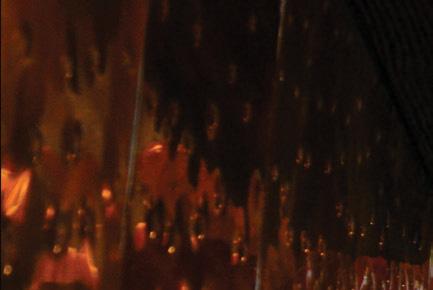




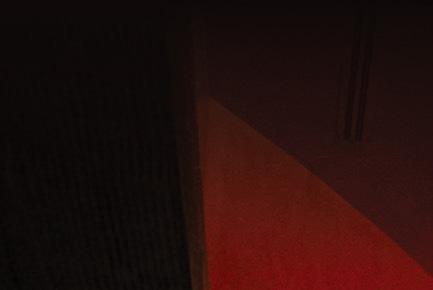
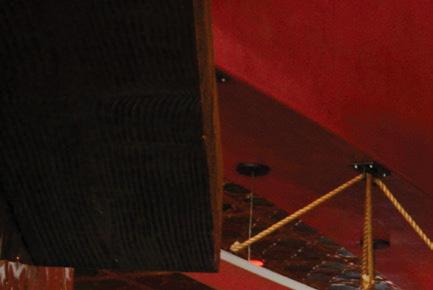

























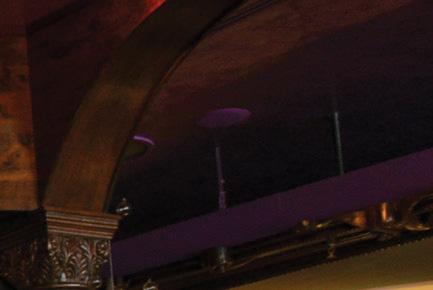












 BY DAVID GRAY ADLER
BY DAVID GRAY ADLER
Underappreciated by many and frequently demeaned and denigrated by those seeking and holding political o ce, the First Amendment guarantee of freedom of the press is, nevertheless, indispensable to our democracy. e founders understood its importance. James Madison referred to press freedom as the “choicest” of the great rights of mankind. omas Je erson, often critical of newspapers who criticized him, wrote in 1786, that “our liberty depends on freedom of the press.” A year later, he addressed the informing function of the press, which he and others understood to constitute the essential rationale for its constitutional protection: “ e basis of our governments being the opinion of the people, the very rst object should be to keep that right; and were it left to me to decide whether we should have a government without newspapers or newspapers without a government, I should not hesitate a moment to prefer the latter.”


e origins and development of freedom of the press in early America had more to do with newspaper practices and citizen desires and expectations than with statutory law, common law, and legal theory. By the time the First Congress proposed the Bill of Rights in 1789, the First Amendment,
justly characterized as the bedrock upon which all liberties rest, exalted freedom of the press because it was widely viewed as inextricably linked to popular government. A free people who intended to govern themselves required information about governmental activities, policies, programs, and laws. e electoral process itself would have been a farce if voters were not aided by the press in their quest to learn what candidates stood for and what their records showed about their past performance, credentials, and quali cations for o ce.
Since the dawn of the Republic, it might be said, freedom of the press was seen as indispensable to a free government that was accountable to the citizenry.
e constitutional protection carved out in the First Amendment—“Congress shall make no law abridging freedom of the press”—meant that the press had achieved a special status as an uno cial fourth branch of government. e “Fourth Estate” functioned as a check upon the three branches of government, exposing misdeeds, deceit, and injustices as well as policies and programs that undermined the public interest. e critical watchdog role of the press meant that it had become a “tribune” of the people, as the names of some newspapers—the Chicago Tribune,
for example—proudly declared. A tribune sat in judgment of the conduct of public o cials because ordinary citizens could not.
At the time of the founding, freedom of the press encompassed the right to engage in robust, virulent, corrosive, and o ensive discussions on the issues of the day.

“Truth,” since the watershed Peter Zenger trial in 1735, had become an accepted defense in vigorous criticisms in attacks on government o cials, demonstrating that the straitjacket of seditious libel was unsuited to republicanism. Indeed, the construction of the First Amendment itself was grounded on what was then a novel and democratic theory that the survival of popular governance requires protection for political discourse.
e American Revolution rejected the English concept of subjects who serve the Crown. Popular government trumpets the principle that government rests on the consent of the people, exists to serve them and, it must be emphasized, is constitutionally limited. A government based on elections requires a citizenry informed by a free press so that it can make intelligent choices. e press, like other professions and the people themselves, may make mistakes, and may occasionally abuse its rights, but free government is impossible without it.




(Part I)

Led by Tona Henderson, the Idaho Downwinders have spent two decades advocating federal recognition and compensation for those a ected by nuclear testing
BY MICAH DREWEmmett City Councilor Tona Henderson lived most of her life believing that taxes and death by cancer were inevitable.
“I’ve done genealogy research for a long time just to see where my family came from and so I’ve looked at lots of obituaries and death certi cates, and at the time I thought it was pretty normal to see many people who have
died from cancer,” Henderson said. Forty- ve of her relatives, who all lived in Gem County, were diagnosed with cancer, 15 of whom died from it. “Growing up, I always heard people say, ‘if you don’t die of old age or a car wreck, you’ll die from cancer.’”
Henderson is the founder and director of Idaho Downwinders, a nonpro t which represents people who lived in Idaho during the height of the United
www.idahomemagazine.com
States’ nuclear weapons testing in Nevada and were subject to radioactive fallout.
Her advocacy work began in the early 2000s when groups of Emmett residents would gather in the Rumor Mill, the donut shop she owned, and talk about their experiences with cancer and suspicions that it was related to radiation exposure from the 100 known above ground nuclear explosions carried out between 1951 and 1953.
She remembers the devastating impact to the community truly sinking in when a series of reporters from the Times, Reader’s Digest, and Spokesman-Review visited the town to talk to those a ected.
“One of them, she told me she’d never met someone with a thyroid problem in her life,” Henderson recalled. In the donut shop that day were 14 people who either had thyroid cancer or needed medication for thyroid conditions. “I realized we needed to do something on a grander scale so people can tell their stories.”
On Sept. 11, 2004, Henderson organized the rst rally of the Idaho Downwinders in Emmett, inviting every elected o cial in Idaho. More than 300 people showed up and shared their stories, including Shari Garman, who Henderson attributes to kicking o the Downwinder furor in Idaho.
Garman, an Emmett native, survived a bout of thyroid cancer, but passed away a year after the rst Idaho Downwinders rally after four additional cancers spread throughout her body. e latter part of her life had been dedicated to getting the federal government to acknowledge their role in harming Idahoans.
20 years later, Henderson is still ghting.
“Shari didn’t smoke, didn’t drink, she lived a healthy life, but she still su ered because of what happened,” Henderson said. “She asked me, ‘Please don’t give up on this,’ and I made the promise not to, but it’s really hard. I can’t give up on it. It is just unbelievable that people can turn a blind eye to this.”
In the 1950s and 1960s, the bulk of the United States’ nuclear weapons testing occurred at the Nevada Test Site, a 680 square mile stretch of desert, chosen speci cally for its lack of proximity to, well, anywhere. Las Vegas is the closest metropolitan area, 65 miles to the southeast, but westerly winds that whipped through the desert were expected to carry any radioactive clouds away from populated areas. e only American citizens government o cials thought may be a ected—primarily living in southern Utah and northern Nevada—were termed “low-use segments of the population,” according to formerly classi ed Atomic Energy Commission documents.
“ at’s the way we’ve been thought of all these years,” Henderson said.











On June 5, 1952, the U.S. government detonated the “How” bomb, a 14-kiloton nuclear weapon that sent a radioactive mushroom cloud more than six miles into the atmosphere. Over the next two weeks, the radioactive fallout drifted some 450 miles to the north into Idaho.
Accounts from residents during that time mention seeing their elds and orchards covered in a gray-white dusting that seemingly appeared out of nowhere. e fallout included high concentrations of radioactive Iodine131, an isotope linked to increased risks of thyroid and other cancers and is found in high concentrations in the milk of cows and goats that graze in contaminated elds.
According to a 1997 study by the National Cancer Institute, of the top ve counties that received the highest radiation dose from nuclear weapons testing, four are in Idaho—Gem, Blaine, Custer, and Lemhi.
Henderson’s parents were married in Emmett two weeks after the “How” detonation and held a wedding reception outside.
Only around 8,000 people live in Emmett. Since 2004, Henderson has recorded 1,140 instances of cancer diagnoses among Emmett residents, including her parents and two older brothers.
“It continues to strike me every time I add to this list, the devastating impact of this,” Henderson said.
ere is currently a federal statute in place that recognizes the impact of radiation fallout and provides monetary compensation for individuals who contracted cancer and several other diseases related to radiation, but Idahoans are not part of it.
e Radiation Exposure Compensation Act, or RECA, passed in 1990 and included compensation of up to $50,000 for “Downwinders,” living in 21 counties spread across Nevada, Utah, and Arizona during the height of the testing. RECA also compensates uranium mine workers in 11 states, including Idaho.
Henderson’s primary goal over the last 20 years has been to expand RECA to include other heavily a ected communities—speci cally looking at those counties identi ed by the National Cancer Institute as bearing the brunt of radioactive fallout. Over the years, she’s met with congressional delegations from multiple states, testi ed before Senate committees, and met with
www.idahomemagazine.com
vice presidents. In December, Henderson said, they got as close as they ever had.
at is in no small part because of Idaho Senator Mike Crapo, the only Idaho o cial who showed up to the rst Downwinders rally in 2004.
“ e engagement [of the Idaho Downwinders] has been critical in telling the true, personal stories of Idahoans who have su ered without recompense,” a spokesperson from Crapo’s o ce told IdaHome. “It was their personal stories at a 2018 Senate Judiciary Committee Hearing that helped garner new support for the bill.”
at bill was an amendment to the 2024 National Defense Authorization Act, which would expand RECA’s geographic eligibility to then-residents of Idaho, Colorado, Montana, New Mexico, and Guam, and would extend RECA for 19 years. Crapo championed the amendment in the Senate, and it passed 61-37 last summer.
Unfortunately, the amendment was stripped from the NDAA before it passed through Congress in December.
Speaking on the Senate oor, Crapo told the story of another Emmett resident, Don Harrison, who contracted ve di erent cancers and passed away in 2018.
“Because Emmett received the third-most radiation from being downwind of the Trinity tests, Don Harrison lived on poisoned ground,” Crapo said. “To be clear, the government’s test of nuclear weapons caused this. It is our solemn duty to compensate those who have su ered because of these tests.”
RECA, in its current form, is set to sunset in June of this year, but Crapo and fellow U.S. Senators Josh Hawley (R-MO) and Ben Ray Lujan (D-NM) continue to work on getting a bill to reauthorize and expand the statute to the Senate oor. A standalone bill was introduced on Feb. 29.
While Henderson is hopeful the bill will pass before RECA expires, after 20 years of falling short, she’s not taking any chances to slow her engagement. It’s her duty to continue telling the stories of those who no longer can.
“ ey told us back during testing that we could be part of history. But they targeted us and they lied about it,” Henderson said. “Now, people just die in silence.” is is the rst article in a two-part series. In the next issue, explore ongoing developments, including a new bill to extend and expand RECA.



Among the bevy of forts at the 2024 Treefort Music Fest is Filmfort, a longstanding option to extend one’s passion and interests for art and creativity, an element of curiosity Treefort embraces full-heartedly. For three days, Filmfort will showcase diverse cinematic perspectives for audiences of all ages, ranging from the enigmatic to the experimental to the off-beat.
In addition to film screenings, Filmfort hosts DIY film panels and Q+A sessions with attending Filmfort filmmakers. These discussions extend beyond the screen with inside info and on-set stories about how a story goes from page to screen. For 2024, Filmfort presents a record number of 39 films, which include dozens of short films and several feature-length films.
Kicking off on Thursday, March 21, at 7 p.m., Filmfort will open with a comedy shorts block at The Flicks. In addition, Filmfort will also have a screening at the Idaho State Museum of “Ugly Baby” at 12:30 p.m. on Friday, March 22, which is part of Kidsfort and for all ages. A Local Gems block of all-local films will occur on Friday, March 22, at 11 a.m. at the Boise Centre. Among all the scheduled films, Filmfort has also planned a secret screening at The Flicks on Saturday, March 23, at 7:15 p.m. It is a delightful ending to an exciting and packed slate of movies.
“Our comedy shorts blocks are so popular that we wanted to bump things up for the opening night and kick things off on a high note,” said Filmfort Director Chelsea Smith. “We will have screenings all day Friday and Saturday with The Flicks and Boise Centre venues and at The Bus Station, which is very exciting for this year.”

However, what’s most exciting for this year is screenings at The Bus Station, now the home of The Idaho Film Society—an established nonprofit, which you can read more about in this issue of IdaHome! It’s a retro DIY film space where much is happening for filmmakers and film enthusiasts.
“The Bus Station was such a hit for 2023 that I think many people will be very curious to see what is now with the Boise Film Society in the space,” said Smith. “It’s very fun, and now it’s a little more formalized and a great place to see a few films.”
A few suggested films include the world premiere of “Stockton to Table Rock,” a drama shot and edited in Boise, directed by Elliot Norton and scored by Boise artist Jesse Blake Rundle. “Stockton to Table Rock” is a coming-of-age drama about a high school senior who confronts her abusive mother and wrestles with whether forgiveness is possible weeks before her high school graduation.
Another particular film by Sara Burke and Aaron Keene to see is “Can’t Seem to Make You Mine.” It portrays a gritty and real situation about a man released from prison trying to make amends with his ex and become a father to his six-year-old son while

staying with a stripper he met on a pen-pal website. Also adding to the slate of must-see films is ”RATS!,” a raucous, over-the-top horror comedy about the misadventures of Emo-era delinquents. And there are plenty more films to watch for all tastes throughout the three-day film celebration.
Filmfort is happening Thursday, March 21, through Saturday, March 23, during Treefort Music Fest 2024. Films will screen at The Flicks, Boise Centre, and with the Idaho Film Society at The Bus Station. All films are included with a 1-day or 5-day Festival Pass or a Filmfort Badge, which is $30. Filmfort venues are for all ages, but not all content may suit younger audiences. For a schedule and information about Filmfort screenings, events, and locations, visit treefortmusicfest.com/ filmfort-2024/.
 “Love and Work,” a film directed by Pete Ohs, tells the story of Diane and Fox, two people who love to work in a world where jobs are illegal. PHOTO COURTESY OF TREEFORT MUSIC FEST
See “Eclipsed” and other short films at Treefort Music Fest’s Filmfort with screenings and other events at The Flicks, Boise Centre, and Idaho Film Society. PHOTO COURTESY OF TREEFORT MUSIC FEST
“Love and Work,” a film directed by Pete Ohs, tells the story of Diane and Fox, two people who love to work in a world where jobs are illegal. PHOTO COURTESY OF TREEFORT MUSIC FEST
See “Eclipsed” and other short films at Treefort Music Fest’s Filmfort with screenings and other events at The Flicks, Boise Centre, and Idaho Film Society. PHOTO COURTESY OF TREEFORT MUSIC FEST

Created by self-described Luddite filmmaker Aidan Brezonick and HP careerist Rich Raimondi, Idaho Film Society is an amalgam of like-minded heavy hitters that also includes Treefort’s Eric Gilbert, “A Christmas Story” star Peter Billingsley, Visionkit’s Stephani Norell (and more) as board members. The nonprofit, brought together through Brezonick and Raimondi’s kindred
love of films, exists in the former Greyhound station in downtown Boise, a spacious location brimming with the kind of cinematic details that inspire artists of all mediums.
Brezonick and Raimondi have high hopes for IFS, and imagine it might become a revenue-generating creative think-tank, workspace, and equipment source for aspiring cineastes and filmmakers, as well as a springboard for real careers in all levels of cinema.


“There’s already an industry here, particularly in commercial production. We can do more, and it can bring revenue to the state.”
“People want to be in a space where you can show movies and get excited about films...”

Raimondi brings the organizational experience he developed at HP and Bishop Kelly High School, along with his penchant for 1960s/1970s films like “Lawrence of Arabia” and “American Graffiti.” He’s using this knowledge and passion to help tackle obstacles in Boise’s film community, including the lack of tax incentives for production in the Gem State.
“When we formed the Idaho Technology Council, we learned that you have to get your people together and build a case before you can ask for anything. There’s already an industry here, particularly in commercial production. We can do more, and it can bring revenue to the state. It can keep people here who would otherwise go to Chicago, Austin, and Los Angeles,”

said Raimondi. He believes, as do others in the community, that Idaho-born filmmakers who live in other places feel the draw to come back—but there’s no infrastructure to support them.
Of course, there’s an upside to this too. Brezonick and Raimondi both note that making films in Idaho is relatively hassle-free. There’s a reason people do come here, and Brezonick and Raimondi want to grow IFS to show what the community is truly capable of.
“We’re building an Idaho film industry, which doesn’t have to be a Los Angeles film industry in Idaho,” Raimondi explained. In some ways, what we have here is better, even, especially as retired filmmakers and craftspeople continue to call Idaho home.

Once, Brezonick needed help restoring the Egyptian’s old projectors, so he reached out to the Music Box in Chicago. The manager couldn’t help, so instead, their equipment ended up a little closer to home in Wendell, Idaho.
“John Eickhof is one of the last true film technicians left in the country. He owns and lives in the Ace movie theater in downtown Wendell. He’s a retired film technician servicing projectors, installing projectors for celebrities, and staying in his small town collecting film equipment. And because he knew all these people across the country, everyone willed everything to John,” Brezonick explained.
“I went there to see him, and he said, ‘I’ve got all this equipment, and I’m happy to help you and restore these projectors. By the way, do you want all of this stuff?’”
Brezonick couldn’t believe his luck. “So John comes down and fixes up the 35 and 70 mm, with his buddy Phil from Star, Idaho, who are in their 70s. They love film and have industry friends living in Glenns Ferry. We started talking to them about getting prints from them. We never would’ve known about this great network of experienced people [right here],” he said.
So it goes in the film community—and in Idaho. IFS events, often held at the Egyptian, bring cinephiles out of the woodwork.
“We’ve gathered a board of 14 fantastic board members, 40 volunteers, ten film curators, and a partnership with the Egyptian in six months. Boise’s been ready for it for a while. People want to be in a space where you can show movies and get excited about films, talk movies, be a resource with thousands of scripts available for reading or to sit down and work,” said Brezonick.


Gluten-Free and KETO options available
THE FARMHOUSE
Sliced Pancetta, Kale, Asparagus, Caramelized Balsamic Onion Jam, Goat Cheese, Shaved Parmesan
WOOD-FIRED FLAT IRON
Flat Iron Steak, Bleu Cheese, Heirloom Cherry Tomatoes, Caramelized Onions, Arugula, Fresh Parm.
BALSAMIC-GLAZED CHICKEN WINGS
Pine Nut & Scallion Garnish, Creamy Gorgonzola
BAKED GOAT CHEESE
W/ FIRE-ROASTED TOMATOES
Served w/ Fresh Baked Focaccia (Gluten-free option)
FLASH-FRIED CALAMARI
Cocktail sauce, Dragoncello Aioli
SANDWICHES
CALABRIAN CHILE BURGER
Bacon Pepper Jam, Calabrian Chile, Pistachio Nut Butter, Gorgonzola, Arugula
ROSEMARY CHICKEN
Pesto, Sun-Dried Tomatoes, Artichoke Hearts, Fontina Cheese, Gaston’s Ciabatta
SPICY ITALIAN
Cold Cut Cured Meats with Thinly Sliced Posciutto, Capicola, Spicy Calabrese, Sopressata on Gaston’s Ciabatta with Basil Pesto Mayo, Arugula and Fresh Tomato
ITALIAN WEDGE
Baby Iceberg, Red Onion, Roma Tomatoes, Sweet & Spicy Bacon, Creamy Gorgonzola Dressing
CHICKEN ARUGULA BASIL
Spring Mix, Pine Nuts, Sun-Dried Tomatoes, Red Onion, Celery, Fontina, Honey-Balsamic Vinaigrette
CLASSIC CAESAR
Our Legendary Caesar Dressing, Chopped Romaine, Fresh Parmesan, Focaccia Croutons (Wood-Roasted Chicken additional)



Traditional Meat Ragu, Basil, Asiago, Topped with our Signature Meatball
MAC & CHEES
24-month Aged White Cheddar, Parmesan, Asiago, Romano, Fontina
HOUSEMADE SAUSAGE LASAGNA
All-Natural Italian Sausage, Fennel, Marinara, Herbed Ricotta, Mozzarella, Toasted Focaccia
RICOTTA GNOCCHI
House-Braised Beef Ragu, Chianti Broth, Shaved Garlic, Fresh Parmesan
Gluten-Free and KETO options available
Alfredo, Grated Parmesan, Chicken, Bacon, Artichoke Hearts, Roma Tomatoes, Chives
Zucchini, Squash, Asparagus, Portobello, Fire Roasted Tomatoes, Shredded Mozz, Goat Cheese
Roasted Kale, Mozzarella, Sautéed Portobello, Fontina, Parmesan, EVOO
All-Natural Italian Sausage, Cupped Pepperoni, Herbed Portobello, Fior di Latte
Meat, Meat and some Meat… oh yeah, and Cheese!
Fontina, Bleu Cheese, Red Onion, Green Onion, Cilantro
Chicken, Fior di Latte, Olive Oil, Garlic, Creminelli Prosciutto Crudo, Caramelized Onions, Balsamic Glaze


